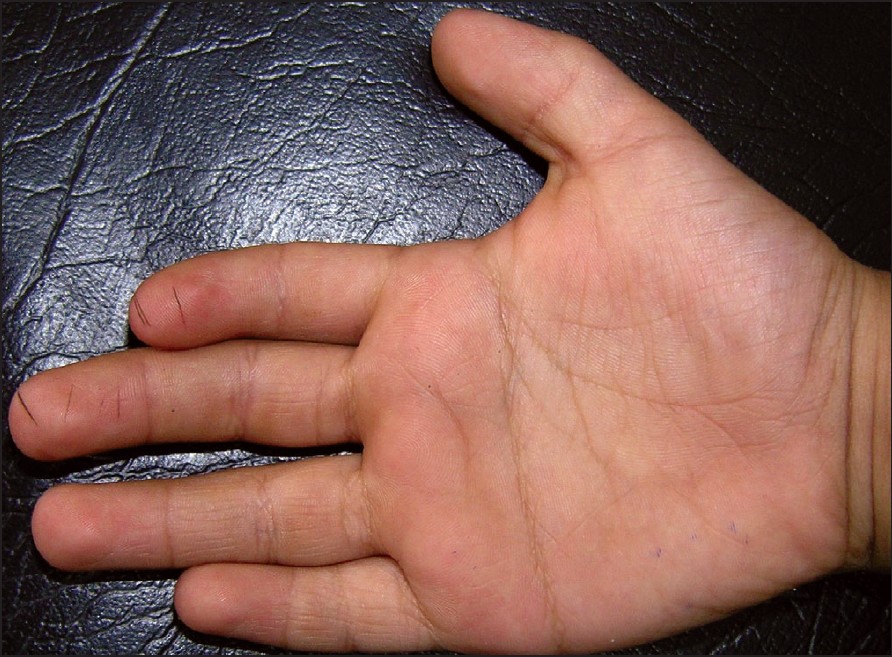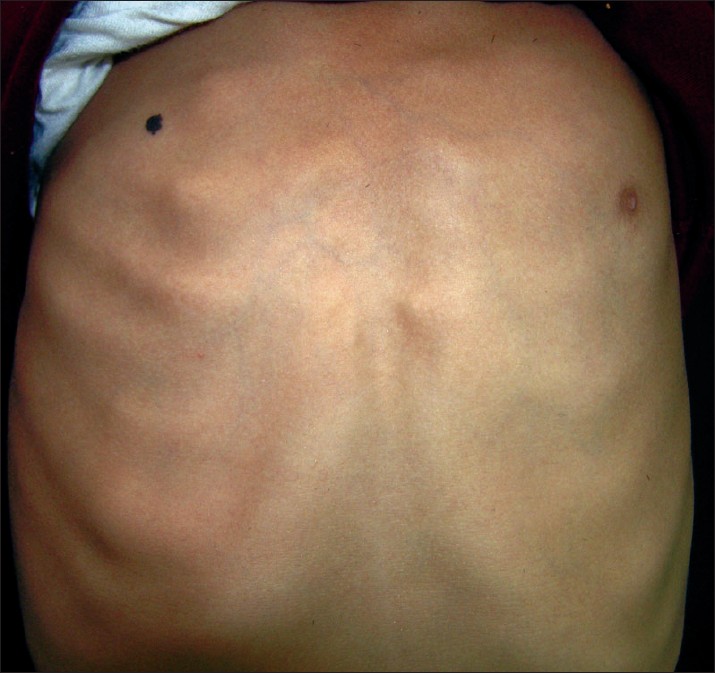Translate this page into:
Poland's syndrome
2 Department of Pediatrics, Uttarakhand Forest Hospital Trust and Medical College, Haldwani, Nainital, Uttarakhand - 263 169, India
Correspondence Address:
Saurabh Agarwal
Department of Dermatology and Venereology, Uttarakhand Forest Hospital Trust and Medical College, Haldwani Nainital, Uttarakhand - 263 139
India
| How to cite this article: Agarwal S, Arya A. Poland's syndrome. Indian J Dermatol Venereol Leprol 2008;74:62-63 |
 |
| Figure 2: Brachydactyly (index finger and thumb) of the right hand and abnormal dermatoglyphics |
 |
| Figure 2: Brachydactyly (index finger and thumb) of the right hand and abnormal dermatoglyphics |
 |
| Figure 1: Partial absence (decreased bulk) of right pectoralis major muscle and absence of right breast |
 |
| Figure 1: Partial absence (decreased bulk) of right pectoralis major muscle and absence of right breast |
Sir,
Poland′s syndrome is a rare congenital anomaly characterized by unilateral chest wall hypoplasia and ipsilateral hand anomalies. We are reporting a 10-year-old boy with right-sided Poland′s syndrome.
A 10-year-old boy presented with complaints of weakness on the right side along with shortening of fingers of the right hand since birth. On cutaneous examination he had decreased muscle bulk (partial absence) of the pectoralis major muscle of the right shoulder girdle and right breast was also absent [Figure - 1]. There was shortening of index finger and thumb (brachydactyly) of the right hand [Figure - 2]. The dermatoglyphics were also abnormal as seen in [Figure - 2]. Other cutaneous examination was unremarkable except a melanocytic nevus on the upper part of the right side of the chest. Systemic examination was within normal limits. His birth history was unremarkable. Family history of similar anomalies was negative.
Chest X- ray showed bifid fourth rib on the right side. There was no dextrocardia. There was anterior protrusion of the right second-eighth costal cartilages (pectus carinatum) seen on lateral chest X-ray. Roentgenograms of the hand confirmed the clinical findings. Other skeletal survey was unremarkable. Ultrasound abdomen did not reveal any abnormality. Routine hematological and biochemical investigations were within normal limits.
Poland′s syndrome, also known as Poland′s sequence or Poland′s anomaly, was first described by Alfred Poland in 1841 [1] and includes partial or complete absence of pectoralis along with ipsilateral hand anomalies, ranging from mild defects to severe bony abnormalities. The incidence ranges from 1 in 7000 to 1 in 100,000 live births. [2] The right side of the body is affected three times more frequently than the left and it is more common in boys than in girls. In most cases Poland′s syndrome is sporadic, with a negligible risk of reoccurrence in the same family. A very few cases are familial. The inheritance can be autosomal dominant; however, variable expressivity and reduced penetrance is usually present.
A compulsory diagnostic criterion for Poland′s syndrome is the presence of aplasia or hypoplasia of the pectoralis major muscle and at least one combined abnormality. Among these, the most frequent are atelia or amastia, hand malformations like syndactyly, brachysyndactyly and symbrachydactyly, upper limb asymmetry, radius/ulna hypoplasia, costal aplasias/hypoplasias, absence of axillary hair, dermatoglyphic abnormalities, dextrocardia, liver/biliary tract anomalies. [2],[3] The extent and involvement of these components are variable and it is rare for all features to be present in the same individual.
Reconstructive surgery is the main course of treatment and includes latissimus dorsi muscle flap and silicone breast implants to give the chest a normal shape. [4] Also, physical therapy may help to develop compensatory muscles of the shoulder girdle and preserve function of the shoulder girdle.
| 1. |
Poland A. Deficiency of the pectoral muscles. Guy Hosp Rep 1841;6:191-3.
[Google Scholar]
|
| 2. |
Fokin AA, Robicsek F. Poland's syndrome revisited. Ann Thorac Surg 2002;74: 2218-25.
[Google Scholar]
|
| 3. |
Urschel HC Jr. Poland's syndrome. Chest Surg Clin North Am 2000;10:393-403.
[Google Scholar]
|
| 4. |
Gatti JE. Poland's deformity reconstructions with customized, extra soft silicone prosthesis. Ann Plast Surg 1997;39:122-30.
[Google Scholar]
|
Fulltext Views
4,062
PDF downloads
3,184





